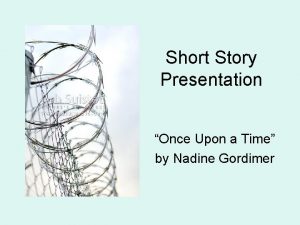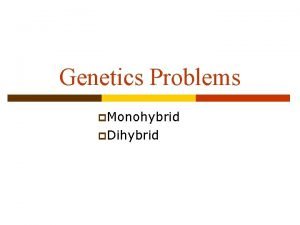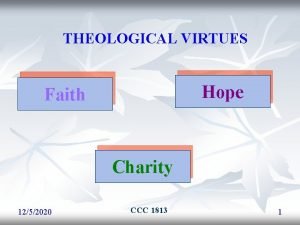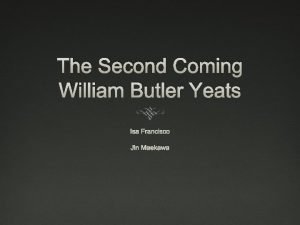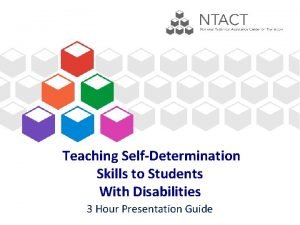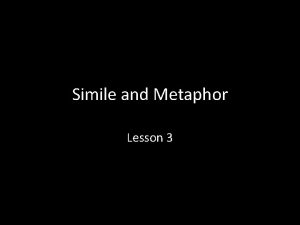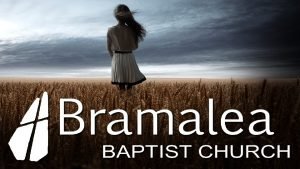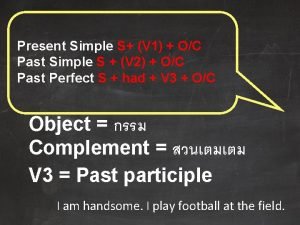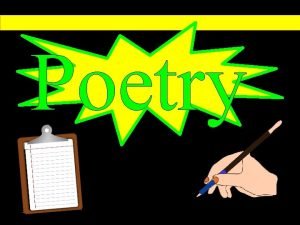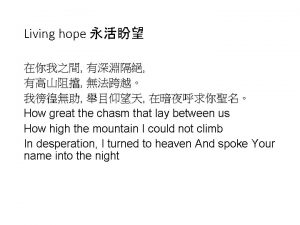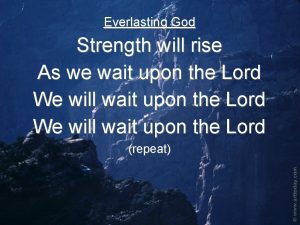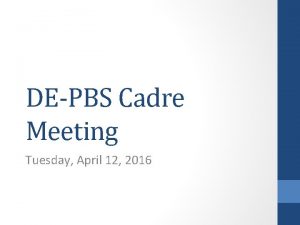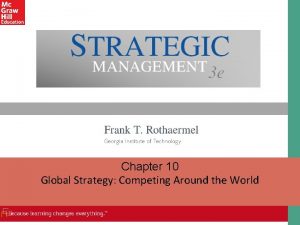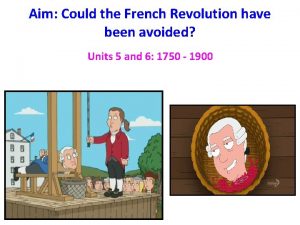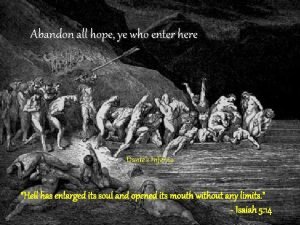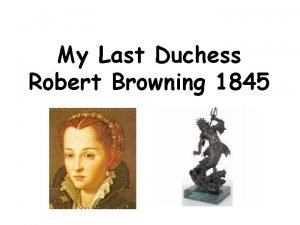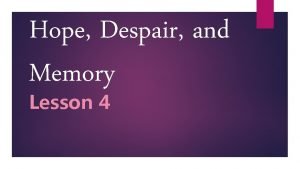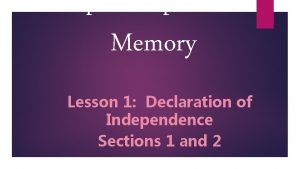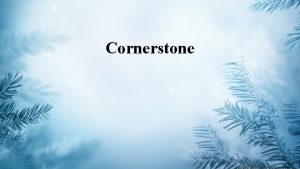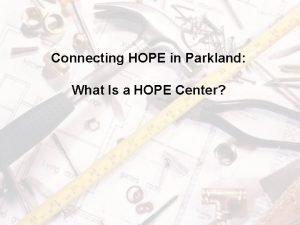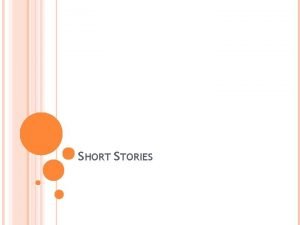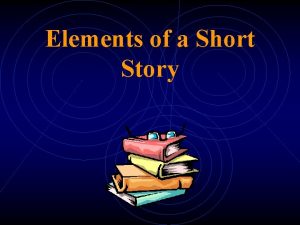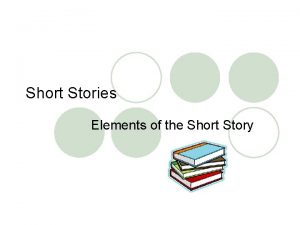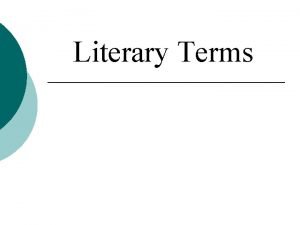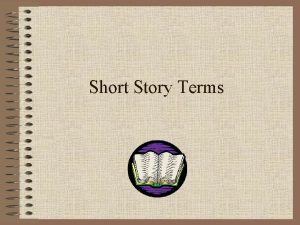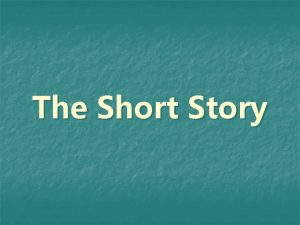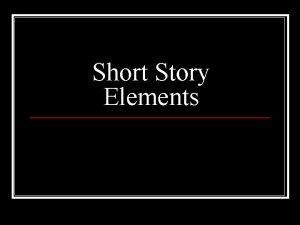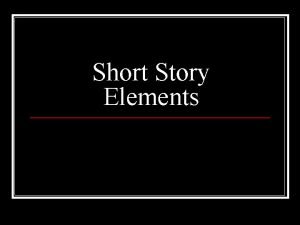Short Story Workshop John Hope Short Story Workshop



































































- Slides: 67

Short Story Workshop John Hope

Short Story Workshop Agenda • • • Writing Overview The Short Story Structure Characters Conflict BREAK Description and Dialog BREAK The Dreaded Re-write Summary 9: 00 am – 10: 30 am – 10: 45 am – 12: 00 pm – 1: 00 pm – 2: 15 pm – 2: 30 pm – 3: 45 pm – 4: 00 pm Teach Break Teach Lunch Teach Break Teach Closing

Writing Overview

Writing Overview • The rules of writing (from this course and others) • • Listen to them Consider them Try them Then, break the rules • Key to excellent writing: Give your story what it needs

The Short Story Structure

The Short Story Structure • What defines a short story? • • Often between 1 k to 5 k words, less than 20 k Contains a COMPLETE story • • Main conflict resolution Character arc • Rich with scene and character description and dialogue • Short fiction has many of the elements of a novel, including character, setting, plot, conflict, resolution, climax, dialogue, protagonist, and antagonist. Maximum 8, 000 words • RPLA Guidelines

Short Stories vs Novels • Similarities • • • Plot curve • • In Novels, scenes are steps toward the resolution Characters Setting • Differences Short Stories have little to no exposition and its primary focus is resolving ONLY the main conflict

Short Stories • Focus on a Key Moment • In order to fit the story within a limited number of words, select the tipping point

Short Stories • Establish basic elements before writing 1. Character(s) • • 2. Combine unusual characteristics Conflict • 3. Make them interesting and believable Character WANTS something, but something or someone is in the way Scene • Many short stories have one scene, make it good and interesting

Characters

Characters • What makes good characters? • • • Definition Depth Heart

• • Characters - Definition What they’re named • • • Names are readers’ first impression Darth Vader, Scout, Harry Potter, Scarlett O'Hara Avoid main character names with the same first letter What they look like • • Readers need a visual Helps to separate characters in readers’ minds

Characters - Definition • What they do • Distinctive quarks • What they say • Distinctive speech • What they think • Creative, funny, odd, stupid, insane, etc.

Characters - Definition • What readers like in characters • • • Has flaws Humble Good character (dependable / keep promises / honest) Live by morals / standards Helpful / compassionate (esp. for certain people) Funny / sense of humor Courageous, yet shows fear Relatable goals Down to Earth / level-headed / even-tempered Smart Cool (esp. in tense moments)

Characters - Definition • What readers don’t like in characters • • • Perfect Liar / undependable / carelessly breaks promises Brags / sees themselves as superior Unsportsmanlike / unfair Self-serving Not funny / bad sense of humor Hidden cowards Unworthy goals Extreme behavior / mood swings Bullies others Whines and complains Panics under pressure

Characters - Want • ALL characters should want something (desire/goal) • If a character doesn’t want something, he/she doesn’t belong in your story • The stronger the want, the better Needs: Air Wants: To Live

Characters - Depth • • • Secrets / Something under the surface • Example: Leader of AA meetings hides liquor for himself Contradiction • • Example: Black-wearing, goth-like, yet loves butterflies Example: Fights for equality, yet fiercely competitive Personal History • • • Background Past struggles / conquests Past relationships Deep-seeded interests, desires Leads to a vulnerability

Characters - Depth Boy Enslaved Resentment Builds Boy into Warrior Bad Guy Kills Mommy Revenge

Characters - Depth • Vulnerability • Achilles heel

Characters Group Activity Character 1

Characters Group Activity Character 2

Character Individual Activity

Conflict

Conflict • Foundation of all storytelling is conflict • • Conflict = Story No Conflict = No Story • Definition of Conflict (from a story’s perspective) • A character wants something, but something is in the way of getting what he/she wants

Conflict • What’s the source of conflict? • What’s at stake?

Source of Conflict • The Four Types of Conflict • • Character-vs-Character-vs-Self Character-vs-Nature Character-vs-Society People Situation

Source of Conflict • People Conflict (Character-vs-Character) • Understanding why people conflict with each other will allow you to build good scenarios • Primary reason for Person-to-Person Conflict: MISCOMMUNICATION

Classic Miscommunication • Juliet faked her death • Romeo thought she was dead, killed himself • When Juliet awoke and found Romeo dead, she killed herself

Miscommunication C A Talking to the Road Runner Talking to Wile E. Coyote D B Understanding the Road Runner Understanding Wile E. Coyote

Source of Conflict • People Conflict (Character-vs-Self) • Both Good Guys and Bad Guys should think they are right, based on their personal objectives/morals

Source of Conflict • Situation Conflict (Character-vs-Nature) • Can be very compelling since obstacles and situations often cannot be defeated or changed easily Terry Fox • Embarked on a cross-Canadian run • Ran for 143 days, covering 3, 339 miles before he died

Source of Conflict • Situation Conflict (Character-vs-Society) • Fighting the norms of society, or a specific group Martin Luther King Jr • Pushed for peaceful reforms • Gave Inspiration to Millions

Conflict • Up against a wall • When characters face resolution to their conflict, they often must ask themselves the following question: What is most important to him/her?

What’s at Stake? • Novels • What’s at stake develops gradually through the course of the story • Short Stories • The stakes may develop, but they need to rise quickly • In both cases: The Bigger the Better!

What’s at Stake? • A Christmas Carol: Ebenezer Scrooge • At Stake: Wasting His Life, Tiny Tim’s Life, Bob Cratchit’s Family, Ebenezer’s Nephew • Lord of the Rings: Frodo • At Stake: The Fate of Middle Earth

Conflict Activity 1 Identifying Conflict • Green Eggs and Ham • • Character-vs-Character-vs-Self Character-vs-Nature Character-vs-Society What? Why?

Conflict Activity 2 Identifying Conflict • Comic • • Character-vs-Character-vs-Self Character-vs-Nature Character-vs-Society What? Why?

Conflict Activity 3 Creating Conflict • • Character-vs-Character-vs-Self Character-vs-Nature Character-vs-Society What? Why? Verses

10 -Minute Break

Description and Dialog

Description and Dialog • Both paint the picture of the characters and their world • Warning! • Too much of either can drown your story “Every sentence must do one of two things—reveal character or advance the action. ” – Kurt Vonnegut

Description • The power of “Less is More” • Using fewer, more powerful words makes writing stronger • Example: • “Jesus wept. ” - John 11: 35

Description • • • Efficiency in Descriptions • Rather than going overboard with flowery language, select the best details, and then move on Bad Example • In this day and age, lazy, sloth-like young people hang out inside the house doing absolutely nothing literately all day. Revised • Now days, kids are lazy. They play video games instead of kickball.

Description • The Description Rules • Be specific, Avoid ambiguity • • • Good: “Sally ate a jelly donut. ” Use action verbs • • • Bad: “Sally ate a pastry. ” Bad: “Jeff went to the kitchen. ” Good: “Jeff skipped to the kitchen. ” Avoid adverbs and passive voice • • Bad: “Mary was dutifully taken to school. ” Good: “Mom drove Mary to school every day. ”

Description • The Description Rules • Use senses (sight, sound, taste, touch) • • • Bad: “Kevin saw the machine in the garage. ” Good: “With repeating clanging pistons and a whiff of burning oil, Kevin felt at home in a stuffy garage. ” Use appropriate language / descriptions • Bad (maybe): “Four-year-old Katie thought the piece of cake towered on her plate like the Leaning Tower of Pisa. ” • Good: “Four-year-old Katie thought the piece of cake was bigger than Daddy’s head. ”

Description • The Description Rules • Avoid duplicating descriptions • • • Bad: “Allister had a huge, enormous, big zit on his nose. ” Good: “Allister had an enormous zit on his nose. ” Bad: “Betty’s noisy cat was louder than a fire alarm. ” Good: “Betty’s cat was louder than a fire alarm. ” Avoid repurposing words • • • Bad: “Zach looked at Tom – he looked surprised. ” Good: “Zach noticed Tom was surprised. ” Better: “Zach noticed Tom’s raised eyebrows and dropped jaw. ”

Description Activity 1 1. 2. 3. 4. 5. Mr. Stevens, who was my former neighbor, won his lawsuit. There is a chat area on the Web called Study Hall that encourages students to talk with one another about college courses. He carries a briefcase made out of leather that is weatherbeaten. The company is taking applications at this point in time.

Description Activity 2 1. Be Specific 2. Action Verbs 3. Use Senses

Dialog • Give each character a “language” (one or more of the following or some other distinctive quality): • • Dialect / mispronunciations (just enough) Use specific words / phrases • • • Elegant wording verses short/choppy Repeated expressions Misuse of words Be true to your characters Keep the plot moving, always • Avoid babbling dialog

Dialog • The Don’ts • • • Info Dumps Repeated Long-winded Monologues Too Much Unreadable Dialect Too Much Info Unrelated to Anything Too Much Talking, Not Enough Action Melodramatic Expressions and Dialog Tags: “Get me a glass of milk!” Mom exclaimed. “We’re out of milk!” Jimmy retorted. “Oh, no! For milk is the source of life!” Mom belted. “I know!” Susie quipped. “I’ll dash to the store!”

Dialog • Listen to actual people talk and mimic (to a degree) in your story’s dialog

Dialog • Make it real, but efficient. Short, choppy lines often do the trick. • Example: I scowled at Randy. “I don’t care, Bubbles. ” “Stop calling me that. ” “Stop calling me Goth. ” “Whatever, Marshall. ” He said my name as if it left a sour taste in his mouth.

Dialog Character Complexity • The hard part about good dialog is the characters’ complexity • • • Each character has distinctive motives and objects Often, characters don’t know how to express themselves There are things some characters don’t want to say

Dialog Activity 1

Dialog Activity 2 • Sock puppets

10 -Minute Break

The Dreaded Re-Write

The Dreaded Re-Write • • First Draft • Get it done, fix it later Re-Write Goals • • • Clean up mistakes (grammar, spelling, clarity, etc. ) Reduce wordiness, replace words/phrases to avoid Vivid details and descriptions Deepen characters / interactions Get more out of each scene Discover theme and focus story on it

The Dreaded Re-Write Clean up Mistakes • Spelling/grammar checker works 90% of the time • Read story out loud • Be as clear as possible • Don’t assume an editor will find all mistakes

The Dreaded Re-Write Words/Phrases to Avoid • • • Adverbs Extraneous Adjectives Oh, yeah. And these (among others): • • • added/in addition about first began almost ask a question anxiously believe eagerly every • • • feel finally frequently got just merely nearly need back up written down • • • but often only so that very then unique presently at the present time

The Dreaded Re-Write Vivid Details and Descriptions • Sight, Smell, Touch, Taste, Sound • Be a sniper • Pick a few very specific details, and move on

The Dreaded Re-Write Deepen Characters / Interactions • You don’t have to know everything about a character in the first draft • • • During the re-write, put yourself in his/her shoes Complete his/her story Reveal characters’ personality, history, and nuances over time

The Dreaded Re-Write Get More Out of Each Scene • Keep adding details that… • Advance the Plot and Reveal Character

The Dreaded Re-Write Discover Theme and Focus Story On It • What’s the point? What are you telling the reader? • • What’s important to you, personally? Leave an impression on your reader

The Dreaded Re-Write Discover Theme and Focus Story On It • Example: Life is Beautiful

Short Story Writing Closing • Read. Learn. Observe. • Have Fun! Be the captain of your imagination.

Short Story Workshop Thank You for Attending
 Tall + short h
Tall + short h Inspirational moral stories
Inspirational moral stories Short stories with the theme of hope
Short stories with the theme of hope Short stories with the theme of hope
Short stories with the theme of hope Once upon a time by nadine gordimer characters
Once upon a time by nadine gordimer characters Are matthew mark luke and john the same story
Are matthew mark luke and john the same story Hh
Hh Planning alternative tomorrows with hope
Planning alternative tomorrows with hope The hope of the believer
The hope of the believer Green hope high school mascot
Green hope high school mascot Hope you had a great summer break
Hope you had a great summer break Happy easter cuz
Happy easter cuz Ccc charity
Ccc charity Wikipedia screenshot
Wikipedia screenshot Peter hope oxera
Peter hope oxera Lugenia burns hope
Lugenia burns hope The hope model
The hope model Laura hope chaffey college
Laura hope chaffey college Hope vs wish
Hope vs wish Email topics
Email topics Planning alternative tomorrows with hope
Planning alternative tomorrows with hope Ojala imperfect subjunctive
Ojala imperfect subjunctive Katerina stoykova
Katerina stoykova Source of hope meaning
Source of hope meaning Hope is the thing with feathers metaphor
Hope is the thing with feathers metaphor What is one example of a telling detail from hope
What is one example of a telling detail from hope Peers for hope house
Peers for hope house Proverbs 13 12
Proverbs 13 12 Hope vs wish
Hope vs wish Acrostic poem learning objectives
Acrostic poem learning objectives Living hope ppt
Living hope ppt Cows in jamaica
Cows in jamaica Hope in christ alone
Hope in christ alone Hope rehab center thailand
Hope rehab center thailand Hi everyone or hi everyone
Hi everyone or hi everyone The color of sunday of the year is green a sign of hope.
The color of sunday of the year is green a sign of hope. We are saved by hope
We are saved by hope Strength will rise
Strength will rise Planning alternative tomorrows with hope
Planning alternative tomorrows with hope Mnes pursuing a multidomestic strategy hope that
Mnes pursuing a multidomestic strategy hope that I hope you enjoyed your vacation reply
I hope you enjoyed your vacation reply Hope chapel apex
Hope chapel apex You should hope that this game will be over soon
You should hope that this game will be over soon Advent joy poem
Advent joy poem Abandon all hope ye who enter here meaning
Abandon all hope ye who enter here meaning Crunkbear
Crunkbear 1 thessalonians 4 nkjv
1 thessalonians 4 nkjv Hope 3 trial
Hope 3 trial Obama hope poster copyright
Obama hope poster copyright Existential-phenomenological forces
Existential-phenomenological forces Officious fool
Officious fool Imagery in macbeth
Imagery in macbeth Ms hope movie
Ms hope movie Hope gpa
Hope gpa Hope despair and memory summary
Hope despair and memory summary What is the main idea of hope despair and memory
What is the main idea of hope despair and memory Hope center vancouver
Hope center vancouver The village lofts pawtucket
The village lofts pawtucket Hello everyone i hope you all are doing well
Hello everyone i hope you all are doing well Growing hope globally
Growing hope globally Virtual hope box
Virtual hope box My hope is built on nothing less images
My hope is built on nothing less images Parkland hope center
Parkland hope center Dispensary of hope murfreesboro tn
Dispensary of hope murfreesboro tn My hope is built on nothing less
My hope is built on nothing less Welcome back hope you had a great vacation
Welcome back hope you had a great vacation Hope you find it helpful
Hope you find it helpful If you don't sleep enough
If you don't sleep enough




